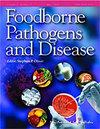Detection of Escherichia coli O157H7 and Campylobacter jejuni in Bovine Carcasses in Two Slaughterhouses in Bio-Bío District, Chile.
IF 1.9
2区 农林科学
Q3 FOOD SCIENCE & TECHNOLOGY
引用次数: 0
Abstract
Escherichia coli O157:H7 (E. coli O157:H7) and Campylobacter jejuni (C. jejuni) are pathogenic microorganisms that can cause severe clinical symptoms in humans and are associated with bovine meat consumption. Specific monitoring for E. coli O157: H7 or C. jejuni in meat is not mandatory under Chilean regulations. In this study, we analyzed 544 samples for the detection of both microorganisms, obtained from 272 bovine carcasses (280 kg average) at two slaughterhouses in the Bio-Bío District, Chile. Sampling was carried out at post-shower of carcasses and after channel passage through the cold chamber. Eleven samples were found to be positive for E. coli O157:H7 (4.0%) using microbiological and biochemical detection techniques and were subjected to a multiplex PCR to detect fliC and rfbE genes. Six samples (2.2%) were also found to be positive for the pathogenicity genes stx1, stx2, and eaeA. Twenty-two carcasses (8.0%) were found to be positive for C. jejuni using microbiological and biochemical detection techniques, but no sample with amplified mapA gene was found.智利比奥比奥区两家屠宰场牛屠体中大肠埃希氏菌 O157H7 和空肠弯曲菌的检测。
大肠杆菌 O157:H7(E. coli O157:H7)和空肠弯曲菌(C. jejuni)是可导致人类出现严重临床症状的致病微生物,与食用牛肉有关。智利的法规并未强制要求对肉类中的大肠杆菌 O157: H7 或空肠弯曲菌进行特定监测。在这项研究中,我们分析了智利比奥比奥区两家屠宰场的 272 头牛(平均 280 千克)的 544 个样本,以检测这两种微生物。采样是在胴体淋浴后和通道通过冷藏室后进行的。使用微生物和生化检测技术发现 11 个样本(4.0%)的大肠杆菌 O157:H7 呈阳性,并进行了多重 PCR 检测 fliC 和 rfbE 基因。有六个样本(2.2%)的致病基因 stx1、stx2 和 eaeA 也呈阳性。通过微生物和生化检测技术,发现 22 个胴体(8.0%)对空肠大肠杆菌呈阳性反应,但没有发现扩增 mapA 基因的样本。
本文章由计算机程序翻译,如有差异,请以英文原文为准。
求助全文
约1分钟内获得全文
求助全文
来源期刊

Foodborne pathogens and disease
医学-食品科技
CiteScore
5.30
自引率
3.60%
发文量
80
审稿时长
1 months
期刊介绍:
Foodborne Pathogens and Disease is one of the most inclusive scientific publications on the many disciplines that contribute to food safety. Spanning an array of issues from "farm-to-fork," the Journal bridges the gap between science and policy to reduce the burden of foodborne illness worldwide.
Foodborne Pathogens and Disease coverage includes:
Agroterrorism
Safety of organically grown and genetically modified foods
Emerging pathogens
Emergence of drug resistance
Methods and technology for rapid and accurate detection
Strategies to destroy or control foodborne pathogens
Novel strategies for the prevention and control of plant and animal diseases that impact food safety
Biosecurity issues and the implications of new regulatory guidelines
Impact of changing lifestyles and consumer demands on food safety.
 求助内容:
求助内容: 应助结果提醒方式:
应助结果提醒方式:


